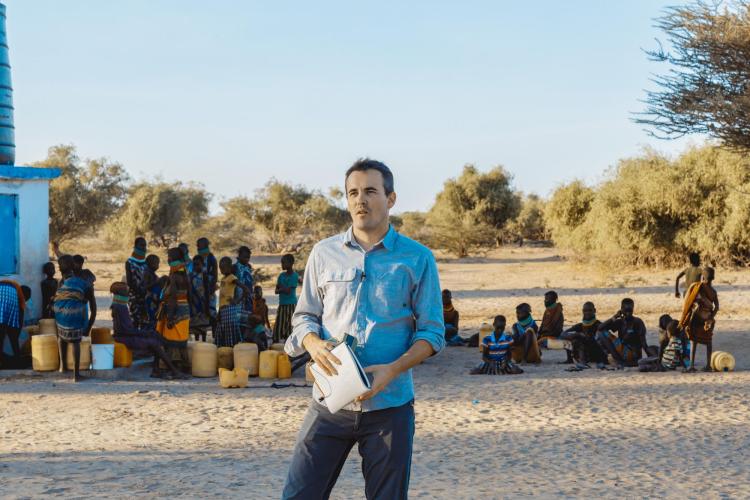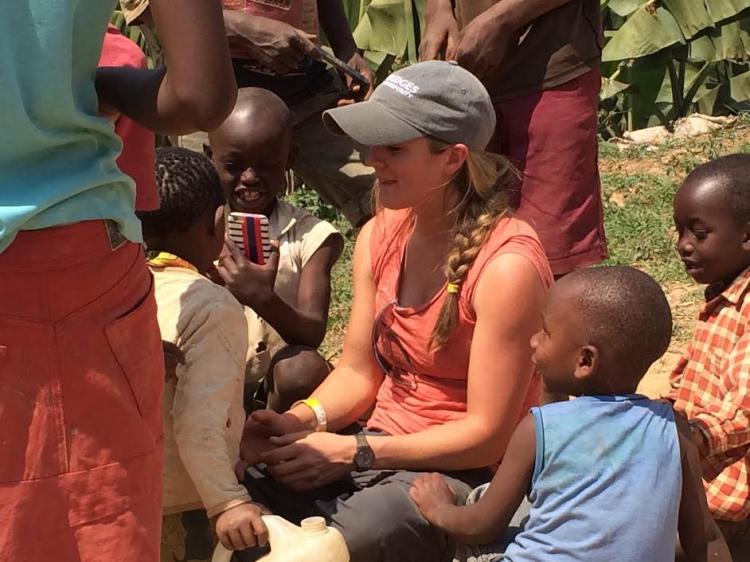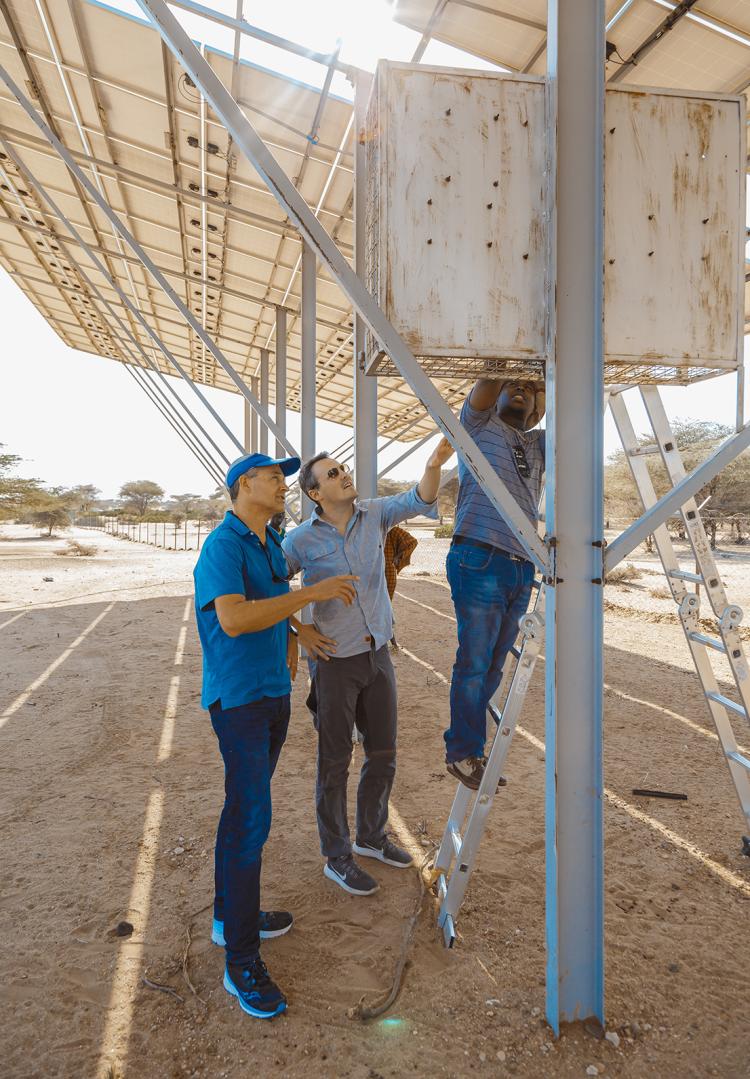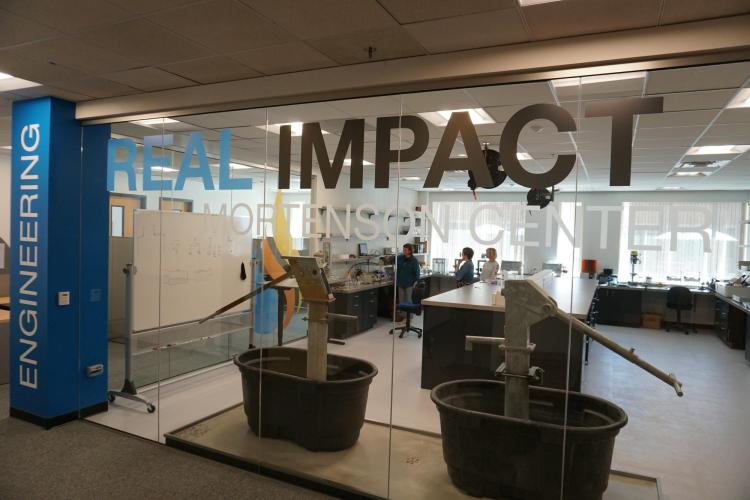"Tangible impact in real terms" - Evan Thomas - Ep. 13
In this episode, OnCUE talks to Associate Professor Evan Thomas about his position as Mortenson Center director. The Mortenson Center in Global Engineering was established by Engineering Professor Bernard Amadei, with a generous endowment from Alice and Mort Mortenson. Thomas became director of the center in July, 2018. He has a long history with CU Boulder and the College of Engineering and Applied Science stretching back to 2001 when he began his undergraduate degree in aerospace engineering, and was one of the first Engineers Without Borders-CU students with Amadei. Thomas has a PhD in aerospace engineering from CU, is a registered professional environmental engineer and has a master’s in public health from the Oregon Health & Science University.
Read more: Evan Thomas lays out new vision and plans for Mortenson Center
[soundcloud width="100%" height="166" scrolling="no" frameborder="no" allow="autoplay" src="https://w.soundcloud.com/player/?url=https%3A//api.soundcloud.com/tracks/610334550&color=%23a49474&auto_play=false&hide_related=false&show_comments=true&show_user=true&show_reposts=false&show_teaser=true"][/soundcloud]
Transcript

Josh Rhoten: Welcome to this edition of On CUE. I'm Josh Rhoten, a communication specialist with the college. I recently sat down with Evan Thomas the new Mortenson center in Engineering for Developing Communities Director to talk about his goals and vision as he takes over the position. A forever buff, he has a long history with the college stretching back to 2001 when he earned his undergraduate degree in aerospace engineering here and was one of the first engineers without borders students. During the discussion we talked about his past work with NASA. His long relationship with Professor Bernard Amadei and the work being done to make the center the pre-eminent education and research destination in the world for engineers wanting to make a positive global impact.
Rhoten: Go ahead and introduce yourself for our listeners.
Evan Thomas: OK, my name is Evan Thomas. I am the Mortenson Endowed Chair in Global Engineering at the University of Colorado Boulder and the director of the Mortenson Center for Engineering and developing communities and I'm an associate professor in the civil environmental and architectural engineering department.
Rhoten: So tell me about the Mortenson Center. What is that for people who may not know?
Thomas: So the Mortenson center is celebrating its 10th year - its 10th anniversary. We were founded by Professor Bernard Amadei day 10 years ago. And over the past 10 years we've developed a curriculum that trains engineering students in technologies, methods and community partnerships to try to address the critical poverty issues of our time. So our students today are working in more than 20 countries around the world every year with community and regional and national government partners and international NGOs and companies working on things like water, sanitation, energy, infrastructure, disaster relief and refugee crises all around the world.
Rhoten: So that's like a growing interesting area for engineers to be involved with right now. Right?
Thomas: These are the most important problems that the world still faces. There's still a billion people in the world that don't have clean water. There are two billion people that don't have safe sanitation. Almost half the world's population still uses firewood for their daily energy needs. And these environmental conditions are leading to the biggest health challenges that the world still faces. Millions of children die every year because of diarrhea or pneumonia which are caused by respiratory issues associated with indoor outdoor air pollution or sanitation and water quality issues. And we can help address these challenges as engineers. Now we don't do it alone. These are issues that we engage with public health professionals and policymakers and community advocates and scientists, but as engineers we can contribute to addressing these challenges through technologies, through methods, through generating evidence that can be translated into positive impact with low- and middle-income communities.
Rhoten: So you're new to CU right now. But I know you're not new in the past. You were a student here before. Can you maybe give some context or background how you got here?
Thomas: Yeah, I first got to see you in 2001 as a freshman and I met Bernard Amadei later that year as the first year that engineers without borders was founded. So as part of our first ever chapter. Now there are hundreds of chapters around the country 15,000 volunteers working in dozens of countries around the world. I was one of Bernard's first students in the EDC program - the engineer for developing communities program - and at the same time I was in the aerospace department here to CU. So I did my undergrad degree in aerospace as well as broadcast journalism and I earned my master's and PhD in aerospace engineering with Dave Klaus in the aerospace engineering department and I went to work for NASA for six years in Houston working on life support systems. So designing and testing systems for air quality and water quality for astronauts in space and I helped to manage projects that flew on the space shuttle and the space station and also new technologies that are 10 or 20 or even 30 years in the future. But while I was at NASA, I actually founded the Engineers Without Borders NASA Johnson Space Center chapter which attracted mission controllers, engineers, scientists, educators and even astronauts to work with us on projects that in Rwanda in particular. And this ended up being a multi-year project between C.U. Boulder and the NASA engineers without borders chapter working in rural communities in Rwanda. And in 2010 the work that we're doing with EWB ended up turning into a company. So I started a company back in 2007 that came up with the idea of taking our community level water treatment projects and tying them to a business model that could actually be self-sufficient.
So we came up with the idea of earning carbon credits from the United Nations that were actually tied to proper maintenance and use of community water treatment systems. And in 2010 we were hired by a water filter company called Vestergaard Frandsen and they make household water filters. They hired our company to take to work in partnership with them and take this idea to scale in Kenya. So I left NASA which is a bit of a hard decision, but NASA knew would go on without me. But this idea wouldn’t, and I went to Portland Oregon and I started as faculty at Portland State University. Ever since then I've had kind of two parallel career paths. One is an entrepreneur running companies that are working in global health and the other as an academic doing a research and teaching in the same field.
So we ran Mana Energy Ltd with Vestergaard Frandsen in 2011. We distributed over nine hundred thousand water filters covering four and a half million people in the western province of Kenya. And this is a project privately financed by the water filter company that then earned revenue from carbon credits. The press from this project ended up getting the attention of a U.K. water test kit company called DelAgua and they hired us next to go back to Rwanda and work with them using private finance to distribute over 100,000 water filters and 350,000 cookstoves is about a $25 million-dollar effort. We worked in seventy-five hundred villages and reach one point seven million people. And again this project was able to earn revenue through proving that people were using the stones and filters selling carbon credits to the World Bank that was reinvested into the program. And we also ran the largest randomized controlled trial that's ever been done. So we were able to prove the positive impact of both the stoves and filters in impacting air and water quality. And in twenty sixteen we sold that company sorry 2015 we sold that company to DelAgua. And I was employed by DelAgua for a number of years running that program. Basically up until the past couple of years where our research team has now moved to CU Boulder and we're continuing to operate a number of our projects around the world in the same area.
Rhoten: That's really interesting. Can you maybe tell me a little bit too about the early days of Engineers Without Borders and those times when you were starting out as a student what it was like with Bernard Amadei on campus?
Thomas: So when Bernard came up with the concept of engineers that Borders USA, it really unearthed this latent passion among engineers, among engineering students. There's a lot of opportunities to get involved in global health and relief efforts if you're a doctor or a physician assistant or a nurse or of your public health professional or if you're in policy. But up until that point there really wasn't a mechanism for engineers to be trained in how to engage in these global challenges. And you can see in the pretty short time that EWB has existed 17 years now 14,000 people are now volunteering every year. In the early days we didn't really know what we were doing. It was very exploratory. We were all passionate to try to address these challenges. We certainly approached it primarily from a what's called the appropriate technology lens - where you try to develop or apply technologies that could be locally produced locally installed locally maintained. And this was effective in some areas there's big successes with appropriate technology. But one of the challenges is scalability. You're not going to reach a billion people with access to clean water doing it one village, one custom project at a time. So today with the Mortenson Center, we're more focused on developing tools and methods that can improve the practice and development more generally. So not necessarily things like sizing rainwater catchment tanks, but actually developing methods and technologies that are scalable. So things like instrumentation sensors that we can install inside water filters and water pumps and borehole schemes to remotely monitor infrastructure and to work with service providers to actually try to professionalize services so not just a village taking care of their own water pump, but a regional or national government being responsible for water services and for recovering costs and for aligning donor payments with a national tax allocation with community payments to really provide water and energy and sanitation services reliably and on a long term basis.
So our role is to help address these service gaps through sensors through impact evaluations through systems thinking and modeling system dynamics that are happening on community and national and international scales through generating evidence that can be more broadly applied in the sector. Through leveraging things like remote sensing satellite data. CU has deep expertise in remote sensing and we're leveraging that expertise to help predict things like drought and famine and floods that are data sets that are actionable on a regional or global scale even. And we're also working with other professionals like the Colorado School of Public Health on things like health impact studies and other forms of impact evaluation that can generate evidence in this field. Another example is our partnership with bridges to prosperity. Bridges to Prosperity was a very small NGO when Avery Bang - who's CU alum and one of Bernard Amadei's students - got involved through CU and -
Rhoten: She just came here and spoke to actually.

Avery Bang
Rhoten: When I hear you speak you talk with a lot of passion and a lot of details. Is it something where you're just fired up to get these changes going? Is it something that really motivates you from inside?
Thomas: So I think what's most exciting is the passion that we have here with our students and our faculty. We have 70 graduate students earning master's and PhDs in the topic area of engineering with developing communities or as we're actually starting to call it global engineering. And this global engineering focus lets our students, our faculty and our staff have tangible impact in real terms within a matter of years. now these are long term commitments. These aren't projects you go do just on spring break. These are multi-year long term commitments, but our masters and PhD students can come into these projects make a significant contribution, learn the ropes of how the sector is done and then they often go off and work for agencies like USAID or the World Bank or big corporations that have contracts in this work like CH2M Hill or AECOM or NGOs like Bridges to Prosperity.
Rhoten: I was curious if you could maybe give some context as to why Boulder is a great place for the Mortenson Center. I know that there's a lot of movement and excitement around the center's new directions and those kinds of things. But Boulder itself seems like a great place to have the center. Can you maybe elaborate on that?
Thomas: The Mortenson Center was founded by Bernard on the day and the passion that he has for trying to address these challenges and Alice and Mort Mortenson the family behind the Mortenson construction firm, bought into that vision. They supported the center with a very generous endowment that lets us have staff, teaching staff, program managers and support our 70 students in the program. And in parallel to that, we're able to bring in a lot of research dollars and other philanthropic dollars to actually act on the work that we're able to develop here.
So we have a 15 million dollar grant from USAID in the Mortenson center that is led by Amy Javernick-Will and Karl Linden operating in Uganda and Ethiopia and in Kenya and they're working in partnership with a whole multitude of other NGOs and universities trying to develop evidence of what works and what doesn't in delivering sustainable water services and systems. We're able to leverage those resources and those projects with a lot of other USAID and UNICEF Autodesk Foundation, Cisco Foundation projects that let us capitalize on our momentum and actually generate more tools and evidence in this sector. And CU Boulder and the Boulder community are a perfect spot for this. We have a long track record of environmental advocacy of environmental studies, environmental science. Engineering is strong and developing tools and methods that generate evidence of the impacts of climate change and the impacts of climate change on human health. And these are all relevant dimensions when we're also talking about trying to make a contribution with lower middle-income countries.

Thomas: If you're a public health professional you have a few options out there for where you would go and earn a master's or PhD. Like Emory University or the London School of Hygiene and Tropical Medicine or the University of California or Johns Hopkins University. There are fewer universities that are specialized in training engineers in how to work in global health and global engineering. We certainly have competition from Berkeley, from M.I.T. from Cal-tech from a number of other places from Stanford. But I think that CU Boulder and the Mortenson Center has the opportunity to become the preeminent destination for engineers wanting to make a global impact.
Rhoten: Can you maybe make a sales pitch on that again about why that's important making that global impact from an engineering perspective having that workforce ready at the people who know how to do those kinds of things?
Thomas: You know I actually don't think we have to pitch very hard. I think we find many students who want to do this. The students are coming to CU already they're going to these other programs because engineers want to show how they're making a positive contribution. There's lots of different professions out there for engineers, but it is more and more obvious that engineers play an important role in addressing global poverty reduction - especially in the face of a changing climate. The passion is there. The challenge is demonstrating where that contribution is and helping to create the pathway for engineers to have successful careers in this area. And there's more and more momentum in that direction. Our alumni work for USAID. They work for the WHO. They work for the World Bank. They work for AECOM. They are already making that difference.
Rhoten: You know one of the other things we talked about too about the importance of having lab space or having facilities here for students is that something that you're looking into and trying to add to the quiver?
Thomas: What are the strategic goals of the College of Engineering is to maximize our global impact. Bobby Brown, our dean, has identified global impact as a one of the successes that we are working to achieve, and the Mortenson center is a piece of that puzzle. As part of that, it's important that space - convening space. So, we now are in the seek building on campus the sustainability environmental and energy collaborative which includes the environment engineer program the Environmental Studies Department a number of the research institutes that we work in renewable energy and atmospheric sciences the sustainability Innovation Lab at Colorado. And we're here too, and we've invested the College of Engineering has invested in building our brand new office spaces for our students and faculty and staff and postdocs and a brand new Mortenson Center lab where we were gonna be developing technologies and methods. And teaching courses in this topic space. Everything from sensors to remote sensing to impact evaluations to water quality testing and developing cookstoves and doing air quality work. And, of course, we don't do it alone. There's a lot of other people already at C.U. who are working in complementary areas. Mike Hannigan in the mechanical engineering department is expert in cookstoves. Katie Dickinson at C.U. Denver is a public health professional doing impact evaluations. Karl Linden runs his water lab where they study technologies for addressing water quality in developing countries. Amy Javernick-Will has her global projects and organizations group that focuses on systems and disaster relief. Bernard Amadei teaches courses in systems sciences and in disasters and all of these are the building blocks that are already here that we're pulling together to show the depth and opportunity that we have for see you to make a global impact.
Rhoten: Tell me about your relationship to Bernard. You've talked about him a couple times in this interview. What's your relationship to him? It goes back a lot of years that we've really talked about.
Thomas: I first cornered Bernard in the hallway in 2001 when I was a freshman and I begged him to let me onto one of his projects. I brought to the table a project we were doing an in Nepal which was to install computers in a very remote Himalayan classroom. This was an undergrad project we had and Bernard adopted it as the first EWB project in Nepal. We then worked together in Rwanda in Afghanistan. He came and helped kick off the Engineers Without Borders chapter at NASA. And we've been collaborators for a long time. So Bernard and Karl Linden and Bobby Braun invited me to come back to CU and help take us forward for the next 10 years of the Mortenson Center.
Rhoten: So in one year's time where you're hoping to be with the center with your own personal or with the center itself maybe one at a time.
Thomas: A year from now, we hope to have restructured our curriculum into modules. So instead of a series of three credit classes that have certain prerequisites, we're hoping to restructure the program into one credit modules that'll be more customizable for students. We want to attract - most of our students today or in the civil and environmental engineering department. We want students from mechanical engineering aerospace engineering computer science electrical engineering from Atlas. We even want students from the Colorado School of Public Health working with our students working on our projects and in our classes and really broaden the base of what the Mortenson Center teaching curriculum is. In addition to that we want to align the teaching with our practice. Our effort is to make a positive global impact. We need to do that through developing tools technologies and methods. We have so many projects going on right now that we can align these together to do to have some big ideas. One of our big ideas is ending drought emergencies. This is using building blocks of all of our existing projects but really broadening our ambitions where we say that here CU - using sensors using remote sensing using analytics working with partners like the Center for Advanced Decision Support - CADSWES - here at see you working with some of the other institutes like Sustainability Innovation Lab, we can have a global impact through reducing and ultimately ending drought emergencies in some regions. Now that's a huge challenge. It's a lifelong challenge, but it's an example of a research area that we are able to really make a global impact with.

Thomas: All students at CU engineering are welcome into the program we have a certificate in engineering for developing communities and you can sign up through our website - https://www.colorado.edu/center/mortenson - or come talk to me or our Managing Director Laura MacDonald how we can work round your schedule. We can also help develop research projects for your master’s or your PhD in collaboration with your primary advisors on things like air quality water quality data analytics machine learning sensor systems there are everything we're doing crises almost every dimension of engineering.
Rhoten: Thank you for your time I appreciate it.
This has been on cue for more information visit Colorado.edu/engineering.

